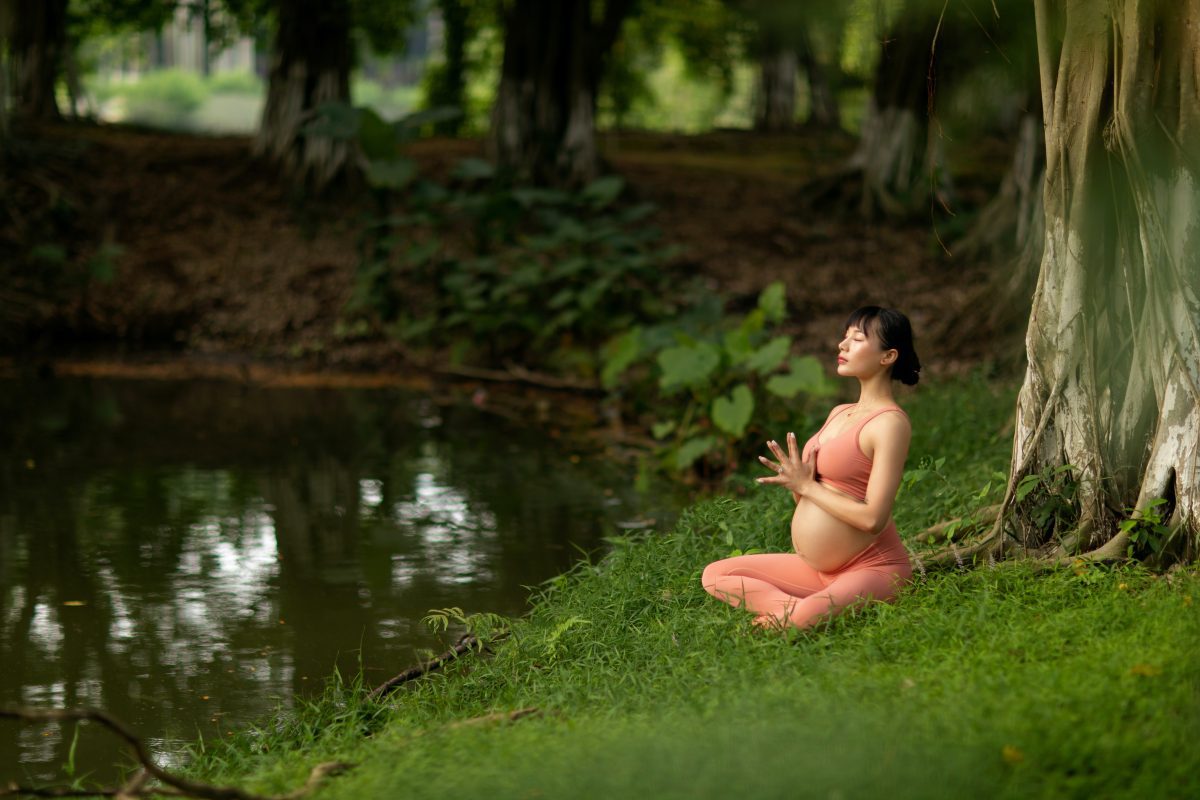
The Connection Between Yoga and Pregnancy
Pregnancy is a profound and transformative journey that brings about incredible changes to a woman’s body and spirit. It is a time of profound connection and nurturing as new life blossoms within. Amidst the physical and emotional changes, many expectant mothers turn to the ancient practice of yoga as a gentle and empowering tool to support their well-being during this miraculous phase of life. The deep and sacred connection between yoga and pregnancy offers a path for women to embrace the transformative power of their bodies and minds, preparing them for the journey of childbirth and motherhood.
Preparing the Mind and Body for the Journey
Preparing the mind and body for the journey of pregnancy and childbirth is essential to the well-being of both the mother and the baby. Yoga helps pregnant women improve physical strength, flexibility, and endurance while also encouraging mental clarity, emotional balance, and spiritual connection. Women can learn to listen to their bodies, acknowledge their limitations, and gain confidence in their abilities to handle the changes and challenges of pregnancy by adopting a regular yoga practise. Moreover, yoga provides a safe and encouraging environment for women to explore their inner landscape, grow in self-awareness, and develop stronger confidence in their intuition and innate wisdom. By approaching pregnancy and childbirth with a mindful and holistic perspective, women can prepare themselves physically, mentally, and emotionally for this transformative journey and embrace the experience with greater ease, joy, and empowerment.
Gentle Asanas for a Nurturing Pregnancy
During pregnancy, engaging in gentle asanas can provide a nurturing and supportive practice for expectant mothers. These poses are designed to promote physical comfort, relieve common pregnancy discomforts, and enhance the overall well-being of both the mother and the baby. Here are a few gentle asanas that can be beneficial during pregnancy:
1. Cat-Cow Pose (Marjaryasana-Bitilasana): This gentle spinal movement helps alleviate back pain, stretches the spine, and releases tension in the shoulders and neck.
2. Supported Bound Angle Pose (Supta Baddha Konasana): With the use of props like bolsters or pillows, this pose gently opens the hips and relaxes the pelvic area, promoting relaxation and relieving tension.
3. Child’s Pose (Balasana): A restorative pose, it helps to release tension in the back, shoulders, and hips while providing a sense of grounding and relaxation.
4. Modified Triangle Pose (Trikonasana): This variation of the traditional triangle pose helps open the hips and provides a gentle stretch to the side body, while maintaining stability and balance.
5. Gentle Forward Fold (Uttanasana): Standing with feet hip-width apart and bending forward with a slight bend in the knees, this pose stretches the hamstrings and releases tension in the lower back.
6. Supported Warrior II Pose (Virabhadrasana II): Using a wall or chair for support, this pose strengthens the legs, opens the hips, and improves stability and concentration.
It is important for pregnant women to listen to their bodies, honor any limitations, and avoid poses that cause discomfort or strain. Consulting with a prenatal yoga instructor or healthcare provider is recommended to ensure a safe and suitable practice during pregnancy. Remember, the intention is to create a nurturing and gentle practice that supports the well-being of both mother and baby.
Harnessing the Power of Breath: Pranayama Techniques for Expectant Mothers
Pranayama or breathing techniques provide a wonderful opportunity for mums-to-be to maintain mindful connections with their unborn baby and deepen their bond. When practised during pregnancy, pranayama can help to reconnect the mother to her unborn child and can assist in focusing on the positive aspects of pregnancy and childbirth. However, it’s important to consult with your healthcare provider before starting any new exercise or breathing practices. They can provide guidance based on your individual circumstances. That being said, here are a few pranayama techniques that are generally considered safe for expectant mothers:
1. Nadi Shodhana or Alternate Nostril Breathing: This breathing technique helps to balance the energy flow in the body and calm the mind.
2. Ujjayi Pranayama or Victorious Breath: This technique helps to calm the mind and reduce stress.
3. Sheetali Pranayama or Cooling Breath: This technique helps to reduce body heat and calm the mind.
4. Bhramari Pranayama or Humming Bee Breath: This technique helps to reduce stress and anxiety and improve focus.
Remember to listen to your body and practice pranayama techniques with care and attention. Avoid holding your breath or straining while breathing.
Alleviating Discomfort: Yoga Practices for Common Pregnancy Symptoms
Pregnancy can bring a range of physical and emotional changes that can sometimes result in discomfort and challenges for expectant mothers. Fortunately, yoga can be an effective tool for managing many common pregnancy symptoms. Here are some yoga practices that can help alleviate these symptoms:
1. Morning sickness: Gentle breathing exercises like Nadi Shodhana (Alternate Nostril Breathing) can help reduce feelings of nausea.
2. Fatigue: Restorative yoga poses like Supported Child’s Pose and Savasana (Corpse Pose) can help reduce fatigue and promote relaxation.
3. Back pain: Prenatal yoga classes often include poses that help alleviate back pain, such as Cat-Cow Pose, Child’s Pose, and Modified Pigeon Pose.
4. Swelling: Restorative yoga poses like Legs-Up-The-Wall Pose can help improve circulation and reduce swelling in the legs and feet.
5. Insomnia: Relaxing yoga poses like Corpse Pose (Savasana) and Restorative Bridge Pose (Setu Bandha Sarvangasana) can help promote relaxation and improve sleep.
6. Anxiety: Yoga practices like pranayama (breathing exercises), meditation, and restorative yoga can help reduce anxiety and promote a sense of calm.
It is important to remember to consult with your healthcare provider before starting any new exercise routine during pregnancy, including yoga. Additionally, pregnant women should listen to their bodies and modify the poses as needed to ensure their comfort and safety. By incorporating these yoga practices into their prenatal routine, expectant mothers can manage common pregnancy symptoms, cultivate a sense of well-being, and prepare themselves for childbirth and motherhood.
Partner Involvement in Prenatal Yoga
Partner yoga during pregnancy can be a wonderful way for expectant parents to deepen their connection and bond with each other and the growing baby. It offers an opportunity to share a physical practice that nurtures both the body and the relationship. Here are some partner yoga poses that can help enhance the prenatal connection:
1. Seated Forward Fold (Paschimottanasana) with Partner: This pose promotes a sense of unity and relaxation.
2. Gentle Backbend with Partner: This pose encourages openness, trust, and shared energy.
3. Supported Squat with Partner: This pose promotes strength, stability, and a sense of grounding.
4. Partner Butterfly Pose: This pose helps open the hips and promotes a sense of connection and intimacy.
5. Reclined Bound Angle Pose with Partner: This pose fosters relaxation, connection, and a sense of shared vulnerability.
When practicing partner yoga during pregnancy, it is important to communicate with each other, listen to your bodies, and respect each other’s limitations. Always prioritize safety and modify the poses as necessary to ensure comfort and avoid strain or injury. Partner yoga can be a beautiful way to nurture the bond between expectant parents and embrace the journey of pregnancy together.
Visualization Exercises and Affirmations to Enhance the Connection
Enhancing the connection between a mother and child during yoga practice can be a beautiful way to foster a deep bond and promote relaxation for both. Here are some visualization exercises and affirmations you can incorporate into your yoga practice to enhance that connection:
Visualization Exercises:
1. Womb of Love: Begin by closing your eyes and taking deep, calming breaths. Visualize your womb as a warm, safe, and loving space filled with a gentle, comforting light. Imagine your baby surrounded by this nurturing light, feeling protected and cherished.
2. Heartbeat Connection: While in a comfortable yoga pose, place your hands on your belly and feel the gentle rise and fall as you breathe. Visualize a golden thread connecting your heart to your baby’s heart. With each inhale, imagine love and positive energy flowing from your heart to your baby, and with each exhale, envision your baby’s love and well-being flowing back to you.
3. Nature’s Harmony: Picture yourself and your baby in a serene natural setting, such as a peaceful forest or a tranquil beach. Visualize the sounds, smells, and sensations of this environment. Imagine the soothing sounds of nature gently surrounding both of you, promoting a sense of calm and unity.
Affirmations:
1. “I am deeply connected to my baby, and our bond grows stronger every day.”
2. “I create a nurturing space within me, where my baby feels safe and loved.”
3. “I trust my body’s wisdom to nourish and support my growing baby.”
4. “Every yoga practice deepens the connection between me and my child, fostering a loving and harmonious relationship.”
Remember, the key is to focus on positive thoughts, feelings, and intentions during your yoga practice. Feel free to adapt and personalize these exercises and affirmations to best suit your unique connection with your baby. Enjoy your yoga journey and the beautiful connection with your little one!
Embracing Relaxation: Restorative Yoga for Tranquility and Rejuvenation
As your baby grows, so should your yoga practice. Embarking on the journey of gentle restorative yoga can help you to nurture your connection with your baby during pregnancy, while providing you with replenishing energy.
Restorative yoga is a type of yoga practice that focuses on relaxation and rejuvenation. It is the perfect complement to a busy lifestyle. During this practice, you relax your muscles and create a tranquil space for yourself. You need not be concerned about the physical change because this yoga practice is gentle and passive.
The poses in restorative yoga are usually held for about 10 minutes, while the practitioner releases any tension present and relaxes into the pose. It can help to reduce any physical and emotional stress that arises from pregnancy. This practice can also help in the preparation of labour. By practicing restorative yoga, you will be able to go to a place of tranquillity and relaxation and gain a sense of inner balance. Practicing this type of yoga can also improve your quality of sleep and help you to feel inner calm. Connecting with your baby is the most desirable outcome, so make sure to practice this type of yoga regularly.
Postpartum Rejuvenation: Yoga Practices for Recovery and Self-care
Postpartum rejuvenation through yoga practices offers a gentle and nurturing approach to support recovery and promote self-care after childbirth. These practices focus on restoring the body’s strength, flexibility, and emotional well-being. Gentle stretching, pelvic floor exercises, and gradual abdominal strengthening help rebuild core muscles while respecting the body’s healing process. Incorporating restorative yoga poses and mindfulness meditation allows for deep relaxation and rejuvenation. By practicing postpartum yoga, women can find solace in self-care rituals, connect with their bodies, and foster a sense of community with other new mothers. It is a journey of self-compassion, patience, and empowerment as women navigate the transformative phase of motherhood and embrace their well-being.

